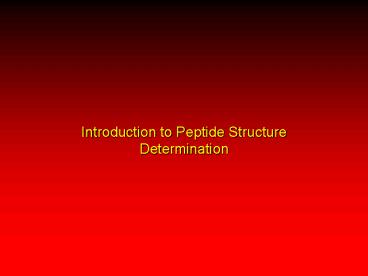Introduction to Peptide Structure Determination - PowerPoint PPT Presentation
1 / 26
Title:
Introduction to Peptide Structure Determination
Description:
Acid-hydrolysis of the peptide (6 M HCl, 24 hr) gives a mixture of amino acids. ... the amino N at the terminus is more nucleophilic than any of the amide nitrogens. ... – PowerPoint PPT presentation
Number of Views:133
Avg rating:3.0/5.0
Title: Introduction to Peptide Structure Determination
1
Introduction to Peptide Structure Determination
2
Amino Acid Analysis
3
Amino Acid Analysis
- Acid-hydrolysis of the peptide (6 M HCl, 24 hr)
gives a mixture of amino acids. - The mixture is separated by ion-exchange
chromatography. - Amino acids are detected using ninhydrin.
- Automated method requires only 10-5 to 10-7 g
of peptide.
4
Partial Hydrolysis of Proteins
5
Partial Hydrolysis of Peptides and Proteins
- Acid-hydrolysis of the peptide cleaves all of the
peptide bonds. - Cleaving some, but not all, of the peptide bonds
gives smaller fragments. - These smaller fragments are then separated and
the amino acids present in each fragment
determined. - Enzyme-catalyzed cleavage is the preferred method
for partial hydrolysis.
6
Carboxypeptidase
Carboxypeptidase is a proteolytic
enzyme(catalyzes the hydrolysis of proteins).
7
Carboxypeptidase
Carboxypeptidase is a proteolytic
enzyme(catalyzes the hydrolysis of proteins).
Carboxypeptidase is selective for cleavingthe
peptide bond to the C-terminal amino acid.
8
Trypsin
Trypsin is selective for cleaving the peptide
bond to the carboxyl group of lysine or arginine.
lysine or arginine
9
Chymotrypsin
Chymotrypsin is selective for cleaving the
peptidebond to the carboxyl group of amino acids
withan aromatic side chain.
phenylalanine, tyrosine, tryptophan
10
End Group Analysis
11
End Group Analysis
- Amino sequence is ambiguous unless we know
whether to read it left-to-right or
right-to-left. - We need to know what the N-terminal and
C-terminal amino acids are. - The C-terminal amino acid can be determined by
carboxypeptidase-catalyzed hydrolysis. - Several chemical methods have been developed for
identifying the N-terminus. They depend on the
fact that the amino N at the terminus is more
nucleophilic than any of the amide nitrogens.
12
Sanger's Method
- The key reagent in Sanger's method for
identifying the N-terminus is 1-fluoro-2,4-dinitro
benzene. - 1-Fluoro-2,4-dinitrobenzene is very reactive
toward nucleophilic aromatic substitution
(Section 23.5).
13
Sanger's Method
- 1-Fluoro-2,4-dinitrobenzene reacts with the amino
nitrogen of the N-terminal amino acid.
14
Sanger's Method
- 1-Fluoro-2,4-dinitrobenzene reacts with the amino
nitrogen of the N-terminal amino acid.
15
Sanger's Method
- Acid hydrolysis cleaves all of the peptide bonds
leaving a mixture of amino acids, only one of
which (the N-terminus) bears a 2,4-DNP group.
16
Sanger's Method
- Acid hydrolysis cleaves all of the peptide bonds
leaving a mixture of amino acids, only one of
which (the N-terminus) bears a 2,4-DNP group.
H3O
17
Sanger's Method
- Acid hydrolysis cleaves all of the peptide bonds
leaving a mixture of amino acids, only one of
which (the N-terminus) bears a 2,4-DNP group.
H3NCHCO
CH3
H3O
18
The Edman Degradation and Automated Sequencing
of Peptides
19
Edman Degradation
- 1. Method for determining N-terminal amino acid.
- 2. Can be done sequentially one residue at a time
on the same sample. Usually one can determine
the first 20 or so amino acids from the
N-terminus by this method. - 3. 10-10 g of sample is sufficient.
- 4. Has been automated.
20
Edman Degradation
- The key reagent in the Edman degradation is
phenyl isothiocyanate.
21
Edman Degradation
- Phenyl isothiocyanate reacts with the amino
nitrogen of the N-terminal amino acid.
22
Edman Degradation
23
Edman Degradation
The product is a phenylthiocarbamoyl
(PTC)derivative.
- The PTC derivative is then treated with HCl in an
anhydrous solvent. The N-terminal amino acid is
cleaved from the remainder of the peptide.
24
Edman Degradation
HCl
25
Edman Degradation
The product is a thiazolone. Under
the conditions of its formation, the
thiazolonerearranges to a phenylthiohydantoin
(PTH) derivative.
26
Edman Degradation
- The PTH derivative is isolated and identified.
The remainder of the peptide is subjected to a
second Edman degradation.































